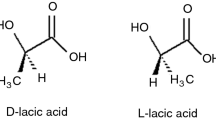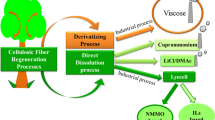Abstract
Preparation and characterisation of liquid epoxidised natural rubber in latex by chemical degradation was successfully carried out. The effect of certain parameters, such as surfactant concentrations, incubation time of ENR latex in the presence of surfactant and pH condition on the reaction efficiency were studied. Effect of degrading agent concentrations and drying temperatures of LENR were also investigated. The molecular weight, i.e., Mw and Mn, which was determined by gel permeation chromatography (GPC) and gel content of LENR were decreased gradually as the degrading agent concentrations increased. Moreover, the drying temperatures, ranging from 333 to 423 K showed no significant changes in epoxidation levels and epoxy derivatives, as the drying period decreased from 24 to 4 h. The resulting LENR were further characterised using Fourier transform infra-red (FTIR) spectroscope, nuclear magnetic resonance (NMR) spectroscope, differential scanning calorimeter (DSC) and field emission-scanning electron microscope (FE-SEM). The glass transition temperature, Tg of LENR, i.e., 252 K was increased compared with ENR, i.e., 248 K. Besides, the latex particles morphology of LENR were found to be more uniform and larger compared with ENR. The functional groups such as carbonyl as functional end group, hydroxyl, epoxy, ester and furan groups were increased after degradation of ENR to form LENR. This indicates that the presence of functional polar groups at the LENR backbone play an important role which brings about the distinguished characters and properties of LENR.


















Similar content being viewed by others
References
Yusof NH, Darji D, Nesan KV B, Rasdi FRM (2018) Preparation of liquid epoxidized natural rubber in latex stage by chemical degradation. In AIP Conference Proceedings (Vol. 1985, No. 1, p. 040006). AIP Publishing
Nair R, Biju PK, Thomas GV, Gopinathan Nair MR (2009) Blends of PVC and epoxidized liquid natural rubber: studies on impact modification. J Appl Polym Sci 111(1):48–56
Yoksan R (2008) Epoxidized natural rubber for adhesive applications. Kasetsart J (Nat Sci) 42:325–332
Yusof NH, Mohd SF (2011) Viscosity reduction of latex using NR-based processing aids. Malaysian Rubber Technology Development, 11(2)
Tan SK, Ahmad S, Chia CH, Mamun A, Heim HP (2013) A comparison study of liquid natural rubber (LNR) and liquid epoxidized natural rubber (LENR) as the toughening agent for epoxy. Am J Mater Sci 3(3):55–61
Saetung A, Rungvichaniwat A, Campistron I, Klinpituksa P, Laguerre A, Phinyocheep P, Pilard JF (2010) Controlled degradation of natural rubber and modification of the obtained telechelic oligoisoprenes: preliminary study of their potentiality as polyurethane foam precursors. J Appl Polym Sci 117(3):1279–1289
Derouet D, Morvan F, Brosse JC (1996) Flame-resistance and thermal stability of 1, 4-polydienes modified by dialkyl (or aryl) phosphates. J Natl Rubber Res (Malaysia)
Sperling LH, Sperling LH (2006) Chapter 3, pg 94–103, Introduction to physical polymer science (Vol. 78). New York: Wiley
Carter WC, Scott RL, Magat M (1946) The viscosity-molecular weight relation for natural rubber. J Am Chem Soc 68(8):1480–1483
Phinyocheep P, Phetphaisit CW, Derouet D, Campistron I, Brosse JC (2005) Chemical degradation of epoxidized natural rubber using periodic acid: preparation of epoxidized liquid natural rubber. J Appl Polym Sci 95(1):6–15
Isa SZ, Yahya R, Hassan A, Tahir M (2007) The influence of temperature and reaction time in the degradation of natural rubber latex. Malays J Anal Sci 11:42–47
Baker CSL, Gelling IR, Newell R (1985) Epoxidized natural rubber. Rubber Chem Technol 58(1):67–85
Gelling IR (1991) Epoxidised natural rubber. J Nat Rubb Res 6(3):184–205
Li SD, Chen Y, Zhou J, Li PS, Zhu CS, Lin ML (1998) Study on the thermal degradation of epoxidized natural rubber. J Appl Polym Sci 67(13):2207–2211
Morand JL (1977) Chain scission in the oxidation of polyisoprene. Rubber Chem Technol 50(2):373–396
Klinklai W, Kawahara S, Mizumo T, Yoshizawa M, Sakdapipanich JT, Isono Y, Ohno H (2003) Depolymerization and ionic conductivity of enzymatically deproteinized natural rubber having epoxy group. Eur Polymer J 39(8):1707–1712
Rooshenass P, Yahya R, Gan SN (2018) Preparation of liquid epoxidized natural rubber by oxidative degradations using periodic acid, potassium permanganate and UV-irradiation. J Polym Environ 26(4):1378–1392
Bonfils F, Char C, Ehabe EE (2008) Intrinsic viscosity characterization of poly (cis-isoprene) in hevea natural rubber. Int J Polym Mater 57(11):1036–1044
Yusof NH, Nesan KVB, Rasdi FRM (2020) Controlling the characteristics of raw natural rubber by partial degradation in the latex stage using a water-soluble degrading agent. J Rubber Res 23(4):301–310
Derouet D, Radhakrishnan N, Brosse JC, Boccaccio G (1994) Phosphorus modification of epoxidized liquid natural rubber to improve flame resistance of vulcanized rubbers. J Appl Polym Sci 52(9):1309–1316
Zhang J, Zhou Q, Jiang XH, Du AK, Zhao T, van Kasteren J, Wang YZ (2010) Oxidation of natural rubber using a sodium tungstate/acetic acid/hydrogen peroxide catalytic system. Polymer Degradation Stability 95(6):1077–1082
Thitithammawong A, Srangkhum S, Rungvichaniwat A (2011) Hydroxytelechelic natural rubber from natural rubber and epoxidised natural rubber. J Rubber Res 14(4):230–440
Baratha KV, Nourry A, Pilard JF (2015) Synthesis of NR based polyurethanes containing phosphorylated polymers as chain extenders. Eur Polymer J 70:317–330
Rooshenass P, Yahya R, Gan SN (2016) Comparison of three different degradation methods to produce liquid epoxidized natural rubber. Rubber Chem Technol 89(1):177–198
Bac NV, Terlemezyan L, Mihailov M (1993) Epoxidation of natural rubber in latex in the presence of a reducing agent. J Appl Polym Sci 50(5):845–849
Darji D, Yusof NH, Rasdi FRM (2018) Shelf life of liquid epoxidized natural rubber (LENR). In AIP Conference Proceedings (Vol. 1985, No. 1, p. 040007). AIP Publishing
Darji D, Yusof NH, Rasdi FRM (2019) Properties of liquid epoxidized natural rubber upon storage. Submitted to JRR
Gelling IR (1982) A method of making epoxidised Cis 1,4-polyisoprene rubber, British Patent, 2. 2 113 692
MRB In-house Test Method UPB/P/022 (2017) Determination of epoxidised level via proton nuclear magnetic resonance spectroscopy, Malaysian Rubber Board
Bach RD, Glukhovtsev MN, Gonzalez C (1998) High-level computational study of the stereoelectronic effects of substituents on alkene epoxidations with peroxyformic acid. J Am Chem Soc 120(38):9902–9910
Lobachev VL, Rudakov ES (2006) The chemistry of peroxynitrite. Reaction mechanisms and kinetics. Russian Chem Rev 75(5):375
Ibrahim S, Daik R, Abdullah I (2014) Functionalization of liquid natural rubber via oxidative degradation of natural rubber. Polymers 6(12):2928–2941
Nawamawat K, Sakdapipanich JT, Ho CC, Ma Y, Song J, Vancso JG (2011) Surface nanostructure of Hevea brasiliensis natural rubber latex particles. Colloids Surf, A 390(1–3):157–166
Yusof NH, Kawahara S, Yamamoto Y, Chaikumpollert O (2015) Preparation of super low protein natural rubber. KGK Rubber Point 68(4):46–51
Luo Y, Yang C, Chen B, Xu K, Zhong J, Peng Z, Wang Q (2013) Thermal degradation of epoxidized natural rubber in presence of neodymium stearate. J Rare Earths 31(5):526–530
Gan SN, Hamid ZA (1997) Partial conversion of epoxide groups to diols in epoxidized natural rubber. Polymer 38(8):1953–1956
Davey JE, Loadman MJR (1984) A chemical demonstration of the randomness of epoxidation of natural rubber. Br Polym J 16(3):134–138
Agapov AL, Wang Y, Kunal K, Robertson CG, Sokolov AP (2012) Effect of polar interactions on polymer dynamics. Macromolecules 45(20):8430–8437
Khalyavina A, Häußler L, Lederer A (2012) Effect of the degree of branching on the glass transition temperature of polyesters. Polymer 53(5):1049–1053
Tarachiwin L, Sakdapipanich JT, Tanaka Y (2005) Relationship between particle size and molecular weight of rubber from Hevea brasiliensis. Rubber Chem Technol 78(4):694–704
Sriring M, Nimpaiboon A, Kumarn S, Sirisinha C, Sakdapipanich J, Toki S (2018) Viscoelastic and mechanical properties of large-and small-particle natural rubber before and after vulcanization. Polym Testing 70:127–134
Tangpakdee J, Mizokoshi M, Endo A, Tanaka Y (1998) Novel method for preparation of low molecular weight natural rubber latex. Rubber Chem Technol 71(4):795–802
Acknowledgements
This research was funded by the Malaysian Rubber Board for Scientific and Economic Advisory Council (SEAC) under project code S17SRP0653B. We highly appreciate and thank Dr. Nghiem Thi Thuong from Hanoi University Science and Technology for the fruitful discussion and valuable advice. A special thanks and appreciation goes to Mdm. Faezah Ismail, Mr. Hamdan Abu Bakar, Mr. Muhammad Saiful, Mdm. Siti Mahirah Romli, Mr. Hishamuddin Samat, Mr. Badrol Hisham, Mr. Faizal and Ms. Nor Fatiah Ismail for their great assistance throughout the work.
Author information
Authors and Affiliations
Corresponding author
Ethics declarations
Conflict of interest
On behalf of all authors, the corresponding author states that there is no conflict of interest.
Additional information
Publisher's Note
Springer Nature remains neutral with regard to jurisdictional claims in published maps and institutional affiliations.
Rights and permissions
About this article
Cite this article
Yusof, N.H., Darji, D., Mohd Rasdi, F.R. et al. Preparation and characterisation of liquid epoxidised natural rubber in latex stage by chemical degradation. J Rubber Res 24, 93–106 (2021). https://doi.org/10.1007/s42464-020-00076-2
Received:
Accepted:
Published:
Issue Date:
DOI: https://doi.org/10.1007/s42464-020-00076-2




